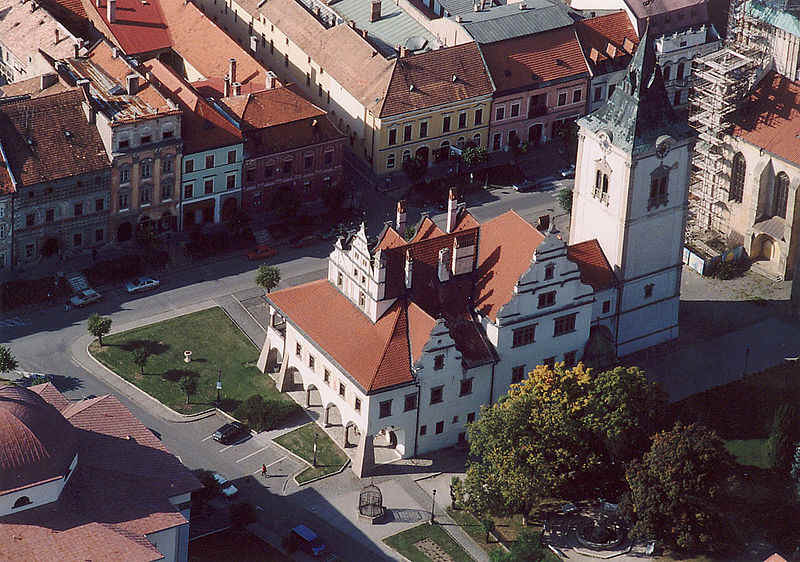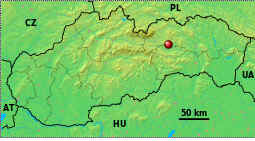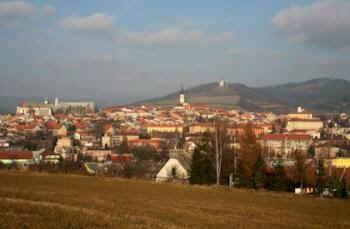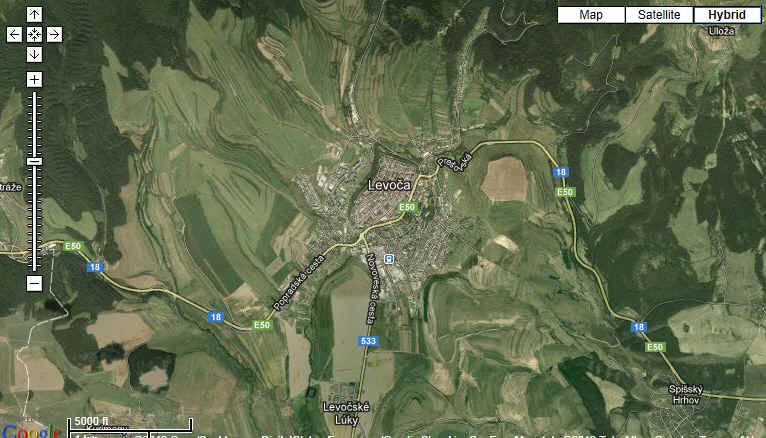|
Levoča

| Levoča
http://de.wikipedia.org/wiki/Levo%C4%8Da |
Levoča ( Aussprache?/i;
deutsch Leutschau, ungarisch Lőcse,
lateinisch Leutsovia) ist eine Stadt im Norden der Slowakei.
Sie liegt in der Zips
und hat 14.796 Einwohner (Stand 31. Dezember 2011). Wegen des
gut erhaltenen Stadtzentrums wurde die Stadt 2009 in das UNESCO-Welterbe
aufgenommen.
Aussprache?/i;
deutsch Leutschau, ungarisch Lőcse,
lateinisch Leutsovia) ist eine Stadt im Norden der Slowakei.
Sie liegt in der Zips
und hat 14.796 Einwohner (Stand 31. Dezember 2011). Wegen des
gut erhaltenen Stadtzentrums wurde die Stadt 2009 in das UNESCO-Welterbe
aufgenommen.
Geographie
Die Stadt befindet sich am Nordrand des Kessels Hornádska
kotlina am Fuße der nördlich gelegenen Leutschauer
Berge. Westlich des Stadtzentrums fließt der Bach Levočský
potok, ein linker Zufluss von Hornád.
Das Stadtzentrum liegt auf einer Höhe von 573
m
n.m. und ist 90 Kilometer von Koice
und 368 Kilometer von Bratislava
entfernt.
Verwaltungstechnisch gliedert sich die Stadt in die
Stadtteile, Levoča (deutsch Leutschau), Levočská
Dolina (deutsch [Leutschauer] Tal), Levočské Lúky
(deutsch Schießplatz) und Závada (1976 eingemeindet;
deutsch Tscherneblod).
Die folgenden Angaben beziehen sich auf die Luftlinie
zum nächsten Ortszentrum und die Entfernungen sind auf halbe
Kilometer kaufmännisch gerundet. Städte sind fett
hervorgehoben.
Geschichte
Die erste dauerhafte Besiedlung der Stadt gab es in der jüngeren
Steinzeit.
Die Slawen besiedelten das Gebiet in 9. bis 11. Jahrhunderten.
Bei dem Weg nach Spiská Nová Ves befand sich das sogenannte
Alte Levoča, wo Archäologen eine Siedlung um die
Fundamente der alten Kirche St. Nikolaus ausmachten; beim
heutigen Kaschauer Tor befand sich noch eine weitere Siedlung
mit romanischen Heilig-Geist-Kirche, eine Rotundenkirche. Mit
den neu gegründeten deutschen Siedlungen, die die eingeladenen
Kolonisten nach dem Mongoleneinfall
1241 angelegt haben, entstand die heutige Stadt.
Die Stadt wurde zum ersten Mal in einer Urkunde des Königs Béla
IV. von 1249 als Leucha schriftlich erwähnt, in
deren ein rechtliches Akt des Grundstückschenkens dem Zipser
Propst behandelt wird. Mit der fortsetzenden deutscher
Besiedlung wurde Leutschau zur bedeutendsten Stadt der Gespanschaft
Zips und wurde 1271 zur Hauptstadt der Provinz der Zipser
Sachsen erklärt. Wie andere Zipser Städte genoss Leutschau
verschiedene Rechte, unter anderem eigene Selbstverwaltung,
Gerichtsbarkeit, Erzförderungsrecht, Recht der Nutzung der Wälder,
Recht des Handels und Lagerrecht. 1317 wurde die Stadt durch den
König Karl
Robert von Anjou zur Freien
Königlichen Stadt erhoben. Der Handel blühte nicht zuletzt
wegen seiner Lage: die Stadt befand sich an einer Kreuzung von
Handelswegen (OstseeBalkan und OstWest). Durch ständige
Privilegien, wie Befreiung von Lagerrecht anderen Städten von
1402 und Befreiung vom Zahlen des Dreißigstelzolls im ganzen Königreich
Ungarn von 1419 war die Stadt sehr reich.[1]
Anfang des 15. Jahrhundert trat Leutschau in den Bund Pentapolis
bei. Regional trat jedoch ein jahrhundertelanger Streit um die Führungsposition
mit der Stadt Käsmark
auf. Nach einem Hussiten-Angriff
im Jahr 1431 brannte die Stadt nieder. Dennoch sind die 15. und
16. Jahrhunderte der Höhepunkt der städtischen Entwicklung
gewesen. In dieser Zeit blühte der Kupferhandel,
mit dessen ist die Familie Thurzo
berühmt geworden und die Bürger handelten mit Krakau, Hansestädten
und Venedig.[2]
Weder der Brand von 1550, bei dem die Mehrheit der gotischen
Architektur verschwand, noch der Brand von 1599 bremste die
Entwicklung. Die reiche Stadt unterstützte Bildung und Kultur.
Bekannte Persönlichkeiten dieser Epoche sind Bildhauer Paul
von Leutschau, englischer Dichter Leonard Cox und Humanist
Johann Henkel. Ein Großteil der Bevölkerung war in den mehr
als 40 Zünften (Gerber, Lederverarbeiter, Schlosser) oder in
verschiedenen Handwerken (Goldschmiede, Bildhauer, Steinmetze,
Maler) tätig.[3]
Doch die Blütenzeit endete Ende des 16. und im ganzen 17.
Jahrhundert, hauptsächlich durch ungarische Ständeaufstände
von Stephan
Bocskay, Gabriel
Bethlen, Franz I. Rákóczi und Franz
II. Rákóczi. Aus dieser Zeit stammen zwei Legenden, die später
zum Subjekt der Romane der ungarischen Schriftsteller Kálmán
Mikszáth und Mór
Jókai geworden sind (siehe Literatur). 1624 wurde die erste
Druckmaschine
der Stadt angelegt und die Stadt war Zentrum der Reformation
in Nordungarn. Im 19. Jahrhundert wurde Leutschau zum kleineren
Zentrum der slowakischen
Nationalbewegung, insbesondere durch den evangelischen
Lyzeum und dazugehörigen Institut der tschecho-slowakischen
Sprache und Literatur. Besonders bekannt ist die Episode von
1844, als die Studenten des Pressburger Lyzeums als Protest
gegen die Absetzung von Ľudovít
túr dort in die Stadt kamen, um ihre Studien fortzusetzen.
Die wirtschaftliche Bedeutung der Stadt verringerte sich
weiter im 19. Jahrhundert, da die neu gebaute Kaschau-Oderberger
Bahn im Jahr 1871 die Stadt 10 km südlich umging und
bediente die Stadt Zipser Neudorf (heute Spiská Nová Ves).
1898 wurde aber noch eine Nebenbahn
von dort errichtet. Trotzdem war die Stadt nur wenig mehr
als administratives Zentrum des Komitats Zips.
Nach dem Zerfall von Österreich-Ungarn im Jahr 1918 kam
Leutschau zur neu entstandenen Tschechoslowakei
(durch den Vertrag
von Trianon völkerrechtlich bestätigt). Während des
Zweiten Weltkriegs wurde die örtliche jüdische Gemeinde fast
vollständig in die deutschen Vernichtungslager abgeschoben.
1950 wurde die Altstadt zur städtischen Denkmalreservation erklärt.
Nach der Unabhängigkeit der Slowakei im Jahr 1993 wurde die
Stadt 1996 erneut Sitz eines Okres. Am 3. Juli 1995 zelebrierte
der Papst Johannes
Paul II. eine Masse am Berg Mariánska
hora in Anwesenheit von 650.000 Wallfahrern.[4]
2009 wurden die Altstadt und die Werke des Paul von Leutschau
in die UNESCO-Welterbeliste
aufgenommen.
Namen
Nachfolgende eine Aufzeichnung der Namen seit der ersten
schriftlichen Erwähnung. Die hier aufgeführten Namen waren
nicht nur zur angegebenen Zeit gebraucht und schließen sich
gegenseitig nicht aus.[5][6]
- 1249: Leucha
- 1268: Lyucha
- 1271: Lewcha
- 1277: Lyucha
- 1284: Leuche, Lyuche, Leiuche
- 1408: Lewscen
- 1479: Lewcsouia
- 1497: Leutschaw
- 1773: Lewuca
- 1786: Lewoče, Lőcse (ungarisch), Leutschau (deutsch),
Leuchovia (lateinisch), Leutschovia, Leutsaria
- 1808: Leutsovia, Lőcse, Leutschau, Lewoča
- 1863-1913: offizieller Name: Lőcse
- seit 1920: heutiger Ortsname: Levoča
Bevölkerung
Auszug aus den Ergebnissen der Volkszählung 2001 (14.366
Einwohner):
|
Nach Ethnie:
- 87,07 % Slowaken
- 11,20 % Zigeuner
- 0,33 % Tschechen
- 0,30 % Ruthenen
- 0,10 % Magyaren
|
Nach Religion:
- 79,54 % römisch-katholisch
- 9,01 % konfessionslos
- 4,52 % keine Angabe
- 3,87 % griechisch-katholisch
- 1,61 % evangelisch
|
Weblinks
|
| Levoča
Wikipedia
http://en.wikipedia.org/wiki/Levoča |
Levoča ( pronunciation
(help·info);
Hungarian:
Lőcse, German:
Leutschau, Polish:
Lewocza) is a town
in the Preov
Region of eastern Slovakia
with a population of 14,600. The town has a historic center with
a well preserved town wall, a Renaissance
church with the highest wooden altar
in World, carved by Master
Paul of Levoča, and many other Renaissance buildings.
pronunciation
(help·info);
Hungarian:
Lőcse, German:
Leutschau, Polish:
Lewocza) is a town
in the Preov
Region of eastern Slovakia
with a population of 14,600. The town has a historic center with
a well preserved town wall, a Renaissance
church with the highest wooden altar
in World, carved by Master
Paul of Levoča, and many other Renaissance buildings.
On 28 June 2009, Levoča was added by UNESCO
to its World
Heritage List
History
Levoča is located in the historical region of Spi
(formerly Szepes),
which was inhabited as early as the Stone
Age. In the 11th century, this region was conquered and,
subsequently, became part of the Kingdom
of Hungary and remained such until 1918. After the Mongol
invasions of 1241/1242, the area was also settled by Germans.
The town became the capital of the Association of Spi Germans,
with a form of self-rule within the Kingdom of Hungary. The
oldest written reference to the city of Levoča dates back
to 1249. In 1317, Levoča (at that time generally known by
the German
name of Leutschau - see Chronology below for lists of changing
names) received the status of a royal town. In 1321 a wide
storing right was granted enticing merchants, craftsmen and mine
owners to settle in this town.
In the 15th century the town, located on an intersection of
trade routes between Poland and Hungary, became a rich center of
commerce. It exported iron, copper, furs, leather, corn, and
wine. At the same time the town became an important cultural
centre. The English humanist Leonard
Cox taught around 1520 in a school in Levoča. The
bookseller Brewer from Wittenberg
transformed his bookstore in a prolific printing plant, that
lasted for 150 years. Finally, one of the best-known medieval
woodcarvers Master
Paul of Levoča settled here.
The town kept this cultural and economic status until the end
of 16th century, in spite of two damaging fires : the first in
1550 destroyed nearly all of the Gothic
architecture and another in 1599. In this period of
prosperity several churches were built and the town had a
school, library, pharmacy, and physicians. There was a printing
press as early as 1624. Levoča was a center of the Protestant
Reformation in Northern Hungary. The town started to decline
during the anti-Habsburg
uprisings in the 17th century.
In a lurid sequence of events in 1700, the mayor of the town
was accidentally wounded by a local nobleman during a hunt,
generating a series of revenge attacks, finally resulting in the
murder of the mayor, Karol Kramler, a Saxon
magistrate. The mayor's arm was then cut off, embalmed, and
preserved in the town hall as a call to further revenge. This
became the subject of a Hungarian
novel about the town, The
Black City, by the writer Kálmán
Mikszáth.[2]
The economic importance of the town was further diminished in
1871 when the important new KoiceBohumín
Railway was built just 8 km (5.0 mi) to the south, bypassing
Levoča and going through the nearby town of Igló, (today
known by its Slovak name, Spiská
Nová Ves). Later, in 1892, only a
spur line was built from Spiská
Nová Ves railway station to Levoča.
After the Treaty
of Trianon and the dismantling of the Kingdom
of Hungary, the city became part of the newly formed Czechoslovakia
and its traditional Slovak name of Levoča was formally
adopted. Later, during World
War II, under the auspices of the First
Slovak Republic, 981 local Jews
were deported from the town to concentration
camps.
On July 3, 1995 Levoča was visited by Pope
John Paul II. He celebrated a mass
for 650,000 celebrants at the traditional pilgrim site of Mariánska
hora, a hill about 2 km north of Levoča with a
spectacular view of the town.
Geography
Levoča lies at an altitude of 570 metres (1,870 ft) above
sea level and covers an area of 64.042 square kilometres
(24.7 sq mi).[3]
It is located in the northern part of the Hornád Basin at the
foothills of the Levoča Hills, at the stream Levočský
potok, a tributary of Hornád.
Poprad
is 25 kilometres (16 mi) away to the west, Preov
50 kilometres (31 mi) to the east, Koice
90 kilometres (56 mi) to the southeast and Bratislava
370 kilometres (230 mi) to the southwest.
|
Location in Slovakia |

|
Historical
Features
The old town is picturesquely sited and still surrounded by
most of its ancient walls. In associating the town with Spi
Castle and ehra
in June 2009 as the renamed World
Heritage Site of "Levoča, Spiský Hrad, and the
Associated Cultural Monuments", UNESCO
cites the town's historic center, its fortifications, and the
works of Master
Paul of Levoča preserved in the town.
The main entrance to the old town is via the monumental Koice
Gate (15th century) behind which is located the ornate
baroque Church of the Holy Spirit and the New Minorite
Monastery (c. 1750).
The town square (Námestie Majstra Pavla - Master
Pauls Square) boasts three major monuments; the quaint Old
Town Hall (15th-17th century) which now contains a museum, the
domed Evangelical
Lutheran Church (1837) and the 14th century Roman
Catholic Church of St. James (in Slovak:
Chrám svätého Jakuba, often mistakenly referred to in
English as St. Jacob's). It houses a magnificently carved and
painted wooden Gothic
altar,
the largest in Europe, (18.62 m (61.09 ft)
in height), created by Master
Paul around 1520. The square is very well preserved (despite
one or two modern incursions) and contains a number of striking
buildings which were the townhouses of the local nobility in the
late Middle Ages. Also notable in the square is the wrought iron
"Cage of Shame", dating back to the 17th century, used
for public punishment of miscreants. A plaque on one of the
houses records the printing and publication in the town of the
most famous work of Comenius,
the Orbis
Pictus. Other buildings on the square house a historical
museum and a museum dedicated to the work of Master Paul.
Behind the square on Klátorská Street are the 14th
century church and remains of the old monastery of the Minorites,
now incorporated into a Church grammar school. Nearby is the
town's Polish Gate, a Gothic construction of the 15th
century.
From the 16th century to the end of 1922, Levoca was the
administrative center of the province of Szepes (Spi). Between
1806 - 1826, the Hungarian architect from Eger Antal Povolny
built a grandiose administration building, the Large Provincial
House, as the seat of the town's administration. He adjusted its
Classicist style to Levoca's Renaissance character by
emphasizing the building's horizontal lines. The House is
considered the most beautiful Provincial House in the former
Kingdom of Hungary. Today, it is reconstructed and it is a seat
of the administration.
The State Regional Archives (tátny oblastný archív)
are in a tan stone building on the north side of the square at nám.
Majstra Pavla 60.
Demographics
Levoča has a population of 14,677 (as of December 31,
2005). According to the 2001 census,
out of 14,366 inhabitants 87.07% were Slovaks
11.20% Roma,
0.33% Czechs
and 0.31% Rusyns.[3]
The religious make-up was 79.54% Roman
Catholics, 9.01% people with no religious affiliation, 3.87%
Greek
Catholics and 1.61% Lutherans.[3]
Town
and nearby settlements
- Levoča (main town)
- Levočská Dolina (=English: Levoča Valley).
About 4 km out of town, on the way to Závada.
- Levočské Lúky (=English: Levoča Fields).
Settlement on the road to Spiska Nová Ves.
- Závada. Village in the hills above Levočská Dolina.
Listing
of town names
Below is a listing of names by which the town of Levoča
has been known or recorded. The names were not necessarily at
any time mutually exclusive and often reflect minor linguistic
differences.[4][5]:
- 1249: Leucha
- 1268: Lyucha
- 1271: Lewcha
- 1277: Lyucha
- 1284: Leuche, Lyuche, Leiuche
- 1408: Lewscen
- 1479: Lewcsouia
- 1497: Leutschaw
- 1773: Lewuca
- 1786: Lewoče, Lőcse (Hungarian), Leutschau
(German), Leuchovia (Latin), Leutschovia, Leutsaria
- 1808: Leutsovia, Lőcse, Leutschau, Lewoča
- 1863 - 1913: official name: Lőcse
- since 1920: official name: Levoča
|
| Levoča
Official Website
http://eng.levoca.sk/ |

The town of Levoča is situated in the centre
- in the heart - of a region called Spi, which is located in
north-east Slovakia bordering on Poland. The region covers
mountainous terrain 573 m above sea level. It is a magnificent
region bordered to the north by the Levoča hills which are a
part of the Carpathian heights whereby to the northwest you may
view the peaks of the lowest alpine-like mountains in Europe -
that is to say the High Tatras.
To the south there is a unique national park known as Slovak
Paradise predominantly consisting of limestone which through the
ages has led to the formation of deep canyons and waterfalls.
In the eastern direction it is connected with the thee mountain
range known as the Slovak Rudohorie. The river Hornád, with its
tributary the Levoča stream, weaves through this area like a
silken thread. The country abounds in mineral water sources and
thermal waters in Vrbov and in Poprad which serve swimming pools.
Levoča is an ideal centre as a starting point for walking
tours. The surroundings abound in a variety of historie monuments
well worth seeing considering their outstanding artistic features.

BASIC INFORMATION
First written reference from 1249
Population 14, 346
Area 6, 404 ha.
Altitude 573 m
Historic town center in 1950 became town monument
reservation
Town Wall almost completely preserved, 6 of 15 bastions
and watch-towers have been preserved as well as three gateways:
Kosicka, Polska and Menhardska Gateways.
Parts of the town Levoca, Levocska Dolina, Levocske Luky,
Zavada (Does this mean that the village of
Zavada was absorbed by Levoca? Home of Anna Labuda) tct
Situation in the north of east Slovakia, district of
Presov, 48 km west of Presov
Tourist trail "Gothic Route" ,267 km long, in
the Spis and Gemer region
Destinations Levoča - Bratislava 370 km
Levoča - Koice 90 km
Slovak anthem The anthem of the Slovak Republic, "Nad
Tatrou sa blyska", was for the first time sung in the Levoca
lycée in the 19th century.
Bank note On the front side of one-hundred-crown note,
there is a picture of Madonna from the main altar in the St
James's Church, made in Master Pavol's workshop. On the back side
of the bank note, there are some features of the St James's Church
and the Town Hall, as well as the illustration of a gothic stone
head from the vestry of the old Minorites church.
COAT OF ARMS OF LEVOCA
Levoca's coat of arms, probably from the 15th
century, consists of the red shield with a double cross on a green
triple hill, which is supported by two silver lions with gold
crowns on their heads. There is a helmet on the shield with the so
called "jewel" on red and white covers, represented by a
gold crown and a silver double cross. Next to the double cross, on
both sides, there are two mussels , the attrributes of the patron
of the town, pictured on several seals, but they are not found in
the heraldry charter.

THE TOWN'S HISTORY
The town's history
It was proved that the town and its surroundins were settled in
the New Stone Age. The old Levoca was situated on the left side of
the road from Levoca to Spisska Nova Ves, where the archaeologists
excavated the foundations of a Roman church, the size of which was
quite respectable: it is 23.5m long, the width of the nave is 12m
and the apse is over 8m. It was the Church of St. Nicholas dating
back to the 11th-12th century . The next large settlement, or a
little town and a rotund church from the 11th century are situated
next to what is now Kosicka Gate. When in the 12th century, and
also after Tartar Raid in 1241,the German colonists arrived in
Levoca, they found the original settlements- the little towns
which, with their own new dwellings, became the foundation of the
present town.
The oldest document, where Levoca
is mentioned for the first time, was issued by Hungarian king Belo
IV in 1249 and he documented the act of presenting the grounds to
the Spis Prior. It says that: "The border of the ground
called Jablonov descends to the road which leads to Levoca."
In 1271 Levoca becomes the center of the Saxons' province and,
like the other Spis towns, uses the rights of free king's towns:
they have autonomy, judicial authority, personal freedom, the
right to mine ores, exploit forests, perform crafts, carry on
trade and the right of store, which caused a long-lasting conflict
with the town of Kezmarok, which won it only thanks to a trick.
The conflict is known as "Hundred-year War" and Levoca
was the winner. In 1402 the citizens of Levoca were freed from the
right of store of other towns, in 1419 the rulers freed Levoca's
merchants from the thirties duty all over Hungary. Thanks to its
advantageous position on the crossroads of trade routes and and
substantial support of the both political and economic priviliges
from the rulers, finances started to flow to the town's treasure,
as well as to the burghers' purses, allowing general development.
It was the period of architectural, educational, cultural,
artistic and crafts splendour. The fires in 1550 and 1599 caused a
lot of damage. But the strong and rich town recovered successfully
from those disasters and kept its significant position till the
end of the 16th century.
The town of Levoca used to be
surrounded by the well -preserved Town-Wall, which was rebuilt
several times. The architecture of the burghers' houses in the
square was changing from Gothic to Renaissance, as we know it now.
Due to the fires, only the remains of the Gothic house have been
preserved and they are discovered during the reconstructions. The
Town Hall is built in Renaissance style, too. Religious
brotherhoods, and especially churches , were the centers of
spiritual culture. The most important were: the Church of St.
Nicholas, Holy Spirit, St. John and probably the Church of St.
Elizabeth, too. But the most significant of them is the church of
European importance, the Church of St. Jacob. Since the 15th
century the town supported education by giving certain sum of
money to school. There were a library, pharmacy, bath and some
doctors worked here as well.
In the last century of this
millenium the town becomes administrative center of district and
later county importance. It is also a town of schools. Still its
most impressive treasure is its heritage- artistic. They were why
the town has become historical reservation in 1950. Life is coming
back to the restored historical buildings thanks to the restorers-
artists and skillful craftsmen. In the stylish buildings, there
are new centers of social, cultural and economic life of the town.
SURROUNDINGS OF LEVOCA
The town of Levoca is dominated by a steep hill
with a Neo-Gothic church- MARIANSKA HORA. It is one of the oldest
and most important pilgrimage places in Slovakia. At the beginning
of July annual pilgrimages take place. It is supposed that a
chapel on Marianska hora was built by the Spis people to thank for
survival at this place in times of Tartar raids in 1241 - 1242.
This place might have been the haven of the town's citizens from
the Tartars in a fortified fort-hill. A chapel on the hill under
the hill-fort was bulit to commemorate the event, and annual
thanksgiving processions started to take place. The people
from neighboring villages joined the processions, which was the
beginning of the first pilgrimage tradition. A new church for the
pilgrims was built in 1906-1914. Its Neo-Gothic altar was
consecrated on 2 July 1922 by the Spis bishop Jan Vojtassak.
Today, a modern pilgrimage house is here as well. The church was
promoted to Basilica Minor in 1984. Coming to Marianska hora is a
source of spiritual energy for thousands of pilgrims each year. In
1955 the Pope visited the place during his stay in Slovakia.
In the direction of Levocska dolina the CAMPSITE-KOVACOVA VILA is
situated. Its oldest part originated in the first half of the 19th
century and its name is derived from the first owners. There are
accomodation and boarding facilities in this splendid countryside.
Nearby, there is a lake with the area of 3.5 ha providing water
sports and fishing facilities. The buildings of former Levoca's
public baths are near the campsite. In the Levoca valley, there is
another culture and nature momument - Kohlwald- to be visited. The
chalet, standing in the shadow of ancient limetrees, used to be a
meeting place for the Stur's supporters. Today, there is a
literary and ethnographic exposition of the Spis Museum. Following
the road via Levocska dolina, we get to
the typical ancient village of Zavada with well-preserved
folk architecture. This place in beautiful countryside, with
cross-country ski-runs, ski slopes, ski lifts and other services,
with accomadation facilities, became the center of winter sports. |
| Levoča
Satellite Map
October 2012
http://www.cisarik.com/0_Galanta_Galanta_TA_Pozsony_Bratislava.html
|


|
| |
|
|